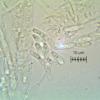
20-12-2025 23:08
Patrice TANCHAUDBonsoir, récolte sur sol sablonneux dans l'arri�

20-12-2025 15:47
Mirek GrycHi.These grew on pine wood that was heavily covere

18-12-2025 21:17
Pol DebaenstThe identification took me to Byssonectria deformi

15-12-2025 07:09
 Danny Newman
Danny Newman
indet. Rutstroemiaceae sp. on unk. fallen leavesMc

19-12-2025 10:10
Patrice TANCHAUDBonjour, récolte réalisée en milieu dunaire, a

18-12-2025 17:23
 Bruno Coué
Bruno Coué
Bonjour,je serais heureux d'avoir votre avis sur c

18-12-2025 18:07
Margot en Geert VullingsThese plumes were found on rotten wood.They strong

17-12-2025 18:35
 Michel Hairaud
Michel Hairaud
Bonjour à tous/Hi to everyone I am passing along
Calycina parilis ?
Maren Kamke,
29-12-2013 23:40
 Hi everybody,
Hi everybody,I found this one on decidious wood. The apothecia are 0,5 mm wide, pale yellow, somewhat translucent, sessile without dark cells in the excipulum.
Hairs are difficult to find, there are two elements beside the asci. both are cylindrical. One type is 4 µm wide and filled with strongly refractive content, which does not dissappear with KOH 3%. The other one, which I think are the paraphyses are 2 µm wide and not filled. The asci are 90-102 x 10-12 µm with croziers, 8-spores, biseriate. The porus-reaction with IKL is dirty purple to blue and of calycina-type. Ascospores becoming 1-septate, rarely 2-septate and develop sidespores with age, (10-14) 11,9 x 3,7 (3-4) µm.Could it be C. parilis?
Thanks and Happy New Year
Maren
Hans-Otto Baral,
30-12-2013 11:58

Re : Calycina parilis ?
Hallo Maren
das ist "Phaeohelotium" trabinellum. Eher eine Calycina, aber auch nicht so recht.
Ich würde gerne den Fundort notieren, da ich vor 10 Jahren einen Artikel darüber angefangen haben...
Grüße
Zotto
das ist "Phaeohelotium" trabinellum. Eher eine Calycina, aber auch nicht so recht.
Ich würde gerne den Fundort notieren, da ich vor 10 Jahren einen Artikel darüber angefangen haben...
Grüße
Zotto
Hans-Otto Baral,
30-12-2013 18:13

Re : Calycina parilis ?
Hi Maren
I had a browser problem which unintentiously translated all english text into German. Now I understand your description better. :-)
you thought that two kinds of paraphyses occur. No, there is only one. Those with refractive content are alive and the narrower ones without are dead. In KOH the refractive contents disappear, certainly. maybe the KOH did not reach the centre of the squashed fungus.
Zotto
I had a browser problem which unintentiously translated all english text into German. Now I understand your description better. :-)
you thought that two kinds of paraphyses occur. No, there is only one. Those with refractive content are alive and the narrower ones without are dead. In KOH the refractive contents disappear, certainly. maybe the KOH did not reach the centre of the squashed fungus.
Zotto
Maren Kamke,
30-12-2013 18:42

Re : Calycina parilis ?
Hi Zotto,
thank you for the information, that was enlightening.
Regards
Maren
thank you for the information, that was enlightening.
Regards
Maren
Stip Helleman,
31-12-2013 02:20

Re : Calycina parilis ?
Hi Maren and Zotto,
Excellent timing, I had it just under the microscope and was breaking my head over the generic position. My collection differs a bit in ascuslength 73-90 x 9-11, spores 8.5-13.5 x 3.5-4 found at the bottom of a 15 cm thick decorticated Quercus branch 1,50 m high (whole tree dead)
The VBs in the low refractive paraphyses were not visible untill IKI was added.
Stip
Excellent timing, I had it just under the microscope and was breaking my head over the generic position. My collection differs a bit in ascuslength 73-90 x 9-11, spores 8.5-13.5 x 3.5-4 found at the bottom of a 15 cm thick decorticated Quercus branch 1,50 m high (whole tree dead)
The VBs in the low refractive paraphyses were not visible untill IKI was added.
Stip
Hans-Otto Baral,
31-12-2013 11:59

Re : Calycina parilis ?
Yes it is! I noted the folowing ascus size:
*(48-)55-93(-110) {7} x (8-)9-11(-12.5) ?m {10}
The mentioned double (subtrabinella Bresadola) has asci
*112-150 x 11.5-12(-13.5) ?m {2}
I would also include collection data of your collection, Stip, if you don't mind.
Zotto
*(48-)55-93(-110) {7} x (8-)9-11(-12.5) ?m {10}
The mentioned double (subtrabinella Bresadola) has asci
*112-150 x 11.5-12(-13.5) ?m {2}
I would also include collection data of your collection, Stip, if you don't mind.
Zotto
Stip Helleman,
31-12-2013 19:34
Hans-Otto Baral,
31-12-2013 20:38

Re : Calycina parilis ?
Danke, die eine genügt :-)
















